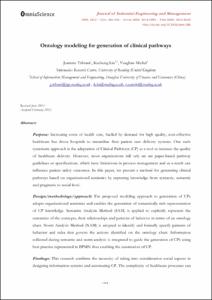Mostra el registre d'ítem simple
Ontology modeling for generation of clinical pathways
| dc.contributor.author | Tehrani, Jasmine |
| dc.contributor.author | Liu, Kecheng |
| dc.contributor.author | Michell, Vaughan |
| dc.date.accessioned | 2013-01-21T14:59:40Z |
| dc.date.available | 2013-01-21T14:59:40Z |
| dc.date.issued | 2012-12 |
| dc.identifier.citation | Tehrani, Jasmine; Liu, Kecheng; Michell, Vaughan. Ontology modeling for generation of clinical pathways. "Journal of Industrial Engineering and Management", Desembre 2012, vol. 5, núm. 2, p. 442-456. |
| dc.identifier.issn | 2013-0953 |
| dc.identifier.uri | http://hdl.handle.net/2099/12963 |
| dc.description.abstract | Purpose: Increasing costs of health care, fuelled by demand for high quality, cost-effective healthcare has drove hospitals to streamline their patient care delivery systems. One such systematic approach is the adaptation of Clinical Pathways (CP) as a tool to increase the quality of healthcare delivery. However, most organizations still rely on are paper-based pathway guidelines or specifications, which have limitations in process management and as a result can influence patient safety outcomes. In this paper, we present a method for generating clinical pathways based on organizational semiotics by capturing knowledge from syntactic, semantic and pragmatic to social level. Design/methodology/approach: The proposed modeling approach to generation of CPs adopts organizational semiotics and enables the generation of semantically rich representation of CP knowledge. Semantic Analysis Method (SAM) is applied to explicitly represent the semantics of the concepts, their relationships and patterns of behavior in terms of an ontology chart. Norm Analysis Method (NAM) is adopted to identify and formally specify patterns of behavior and rules that govern the actions identified on the ontology chart. Information collected during semantic and norm analysis is integrated to guide the generation of CPs using best practice represented in BPMN thus enabling the automation of CP. Findings: This research confirms the necessity of taking into consideration social aspects in designing information systems and automating CP. The complexity of healthcare processes can be best tackled by analyzing stakeholders, which we treat as social agents, their goals and patterns of action within the agent network. Originality/value: The current modeling methods describe CPs from a structural aspect comprising activities, properties and interrelationships. However, these methods lack a mechanism to describe possible patterns of human behavior and the conditions under which the behavior will occur. To overcome this weakness, a semiotic approach to generation of clinical pathway is introduced. The CP generated from SAM together with norms will enrich the knowledge representation of the domain through ontology modeling, which allows the recognition of human responsibilities and obligations and more importantly, the ultimate power of decision making in exceptional circumstances. |
| dc.format.extent | 15 p. |
| dc.language.iso | eng |
| dc.publisher | School of Industrial and Aeronautic Engineering of Terrassa (ETSEIAT). Universitat Politècnica de Catalunya (UPC) |
| dc.rights | Attribution-NonCommercial 3.0 Spain |
| dc.rights.uri | http://creativecommons.org/licenses/by-nc/3.0/es/ |
| dc.subject | Àrees temàtiques de la UPC::Economia i organització d'empreses::Gestió del coneixement |
| dc.subject | Àrees temàtiques de la UPC::Ciències de la salut::Medicina |
| dc.subject.lcsh | Diagnosis - Data processing |
| dc.subject.other | Clinical pathways |
| dc.subject.other | Process modeling |
| dc.subject.other | BPMN |
| dc.subject.other | Organizational semiotics |
| dc.subject.other | Ontology chart |
| dc.subject.other | Semantic analysis method |
| dc.subject.other | Medical quality improvement |
| dc.title | Ontology modeling for generation of clinical pathways |
| dc.type | Article |
| dc.subject.lemac | Diagnòstic -- Informàtica |
| dc.identifier.dl | B-28744-2008 |
| dc.description.peerreviewed | Peer Reviewed |
| dc.rights.access | Open Access |
| local.citation.author | Tehrani, Jasmine; Liu, Kecheng; Michell, Vaughan |
| local.citation.publicationName | Journal of Industrial Engineering and Management |
| local.citation.volume | 5 |
| local.citation.number | 2 |
| local.citation.startingPage | 442 |
| local.citation.endingPage | 456 |
Fitxers d'aquest items
Aquest ítem apareix a les col·leccions següents
-
2012, vol. 5, núm. 2 [16]


